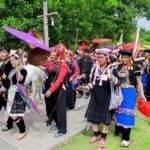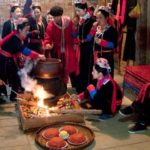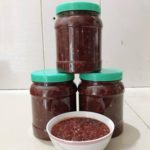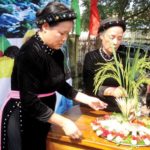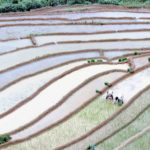The northwestern region is home to many ethnic groups, including the Thai, Tay, Muong, Khang, and Dao.
To prepare for Tet, the Khang in Quynh Nhai district, Son La province, go to the forest to pick dong leaves for wrapping chung cakes and banana leaves to wrap grilled meat.
One day before New Year’s Eve, women often go to a nearby wharf to wash their hair, which is a ritual to say farewell to the old year and welcome the new year.
But this practice should not be done on the last day of the year as the Khang believe that on New Year’s Eve, yin and yang mingle as one. If the women meet evil spirits, they will fall ill and contract diseases. This hair washing taboo is not applied to men.
Lo Thi Phac of Quynh Nhai district says, “To wash the hair, we prepare a basin of rice water. We dip a tree branch in the water, flick over our head three times, and pray to banish all bad luck, sickness, diseases, and bad luck of the old year to drift along rivers and streams. We pray our ancestors to bless ourselves, our relatives, and villagers. We pray the Heaven God for favorable weather, bumper crops, big herds of cattle, and basketful of rice.”
Like other ethnic groups, the Mong practice a number of unique Tet customs as well. Replacing the old ancestral altar with a new one on New Year’s Eve is one of the most important rituals.
In the afternoon of the last day of the year, they cut 3 bamboo branches, tie 3 incense sticks on them, and sweep from every corner of the house to the front door.
Then they sweep the house with a broom to chase away evil spirits and bad luck of the old year, welcoming happiness and peace. The most important work is changing the altar and putting new worship paper on it.
Thao Cu Chia of Thuan Chau district said they prepare a rooster for the offering.
“We change the altar after New Year’s Eve to pray for and welcome happiness at the early time of the year. At about 3 to 4 am we go out to fetch the first bottle of water with a belief of welcoming new fortunes and good luck to the family, so that we’ll have good business, basketfuls of grains, a lot of money, and big herds of animals. In the morning family members should not go far. We just pay Tet visits to neighbors. We don’t spend money.”
The Dao also believe that Tet is an occasion to relax and unite family members after a year of hard work, report to ancestors about the year’s happenings, and pray for good things to come in the future. With respect towards their roots, the Dao attach great importance to ancestral worship.
A month before Tet they prepare pork, rooster, sticky rice, round sticky rice, and wine. Every family stocks enough wood for the fire to last the three days of Tet. The fire keeps them warm in winter and symbolizes happiness and prosperity.
When visiting ethnic groups in the northwestern region on the first day of the year, visitors can explore many typical customs and rituals such as abstaining from calling each other’s name, spending money, and eating vegetables.
Visitors can also join in the celebrations with ethnic people and take in the beautiful scenes of the mountains and forests in spring.
Colours of Vietnam’s ethnic groups in spotlight at Culture Village in April
NDO – A programme entitled ‘Colours of Vietnamese ethnic groups’ will take place throughout this April at the Vietnam National Village for Ethnic Culture and Tourism, in the Dong Mo tourism area of Son Tay town, Hanoi.
Alluring terraced rice fields in Son La
With hundreds of years of experience in rice production, Vietnamese farmers, especially those who live in the northern mountainous region, learned how to adapt to different terrains. That is why rice terraces of Vietnam were formed long ago and are also known as a unique culture and famous tourist attraction.

